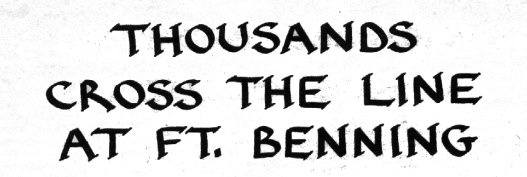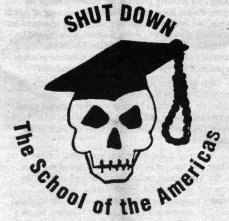

A large and diverse crowd of 7,000 gathered at the main gate of Ft. Benning, Georgia on November 21 and 22, to demand that the U.S. Army School of the Americas (S.O.A.) be shut down. Protesters, ranging in age from infants to people in their 90’s, came from many countries and almost every U.S. state to participate in the 9th annual demonstration at Ft. Benning.
On Saturday, November 21, participants held a spirited rally at the
gate. A multitude of colorful banners and posters were visible throughout
the crowd, while on the stage, wonderful music and inspiring speakers were
occasionally interrupted by loudspeakers from the base blaring warnings
about trespassing to those present. And throughout the day,
those committed to or considering “crossing the line” the following day
filled the pews, balcony and choir seats of a nearby church to attend two-hour
nonviolence training sessions.
“I awoke Sunday with an awareness that crossing the line onto Fort
Benning, and breaking the law in doing so, was not an end in itself.
We were to cross the line because we were a memorial procession, with caskets
and crosses and pictures, and each represented a human being by name who
was dead. Theories could be argued, and facts disputed, but one thing
was absolutely certain; each name was the name of someone who was dead,
someone who would have had a whole life in front of them if they had not
been killed. At that moment, the issue for me was not about breaking
the law, or about risking arrest, or about crossing a line painted on the
road to mark a border; it was not even about which friends I would agree
with and which I would disagree with; it was not even about closing the
SOA. It was about whether I would stand with those who had been killed,
or turn my back on them.”
-Jackson H. Day
SOA protester from Maryland and Vietnam veteran.
On Sunday, November 22, thousands of individuals in front of Ft. Benning’s gate joined their voices together in song, prayer, and the reciting of a pledge of nonviolence. Past S.O.A. prisoners of conscience gathered on stage, and those currently in various U.S. prisons were remembered and honored.
Those going onto the base formed a funeral procession, led by people carrying caskets, followed by a very long line of protesters, four abreast, carrying crosses and pictures representing victims of S.O.A. graduates. Drums kept the rhythm of the silent procession, which continued moving slowly forward across the line - while names of these victims were called out from the stage, one by one, as thousands of people responded, “Presente!”
“All protesters in wheelchairs were told we were to be kept separate
for our safety. Col. Jones, a man who needs some stress reduction
classes, told us ‘we were his to deal with and we weren’t going any further.’
Our choices were to sit there for two days (the time he figured it would
take to process all 2319 people crossing the line) or leave. We sat.
We were not to be intimidated. Time went on. The lines of protesters
passing by us in silent march, four in a row, kept coming and coming.
I couldn’t believe that many people would risk arrest. They came
and came and came. My heart soared. 2319 people. Truly
awesome. Young college students, elderly men and women. Middle
aged folks. I felt hope. Buses came for some of the able bodied.
Off they went. More buses came. Buses like you wouldn’t believe.
Finally Col. Jones came to say that no one would be arrested. Everyone
was being escorted off base and would be released. We could get on
an accessible van or wheel ourselves out. Our choice. We decided
to leave on our own power. We got a ‘heroes’ welcome.”
-Cookie Anderson
SOA protester from Wisconsin
Line-crossers not in wheelchairs were bussed several miles away to a park, where they were handed letters excluding them from the base until midnight, and released. They began walking back through residential areas, joyfully singing and returning the waves of families who had come out of their houses to watch. Columbus police blocked traffic at intersections as over 2,000 people returned to streets leading to the base gate, which were lined with cheering and clapping activists welcoming them back.
Many who crossed the line that day, including lots of students, risked arrest for their very first time - participating in what was the largest civil disobedience action in the U.S. since Vietnam. Also significantly, there were at least 70 protesters at the front of the procession who had received ban and bar letters for crossing the line during past demonstrations at Ft. Benning, and as a result had knowingly risked a likely sentence of six months in prison and $5,000 fine.
S.O.A. Watch organizers are already planning for a large November 2000 gathering - either to continue demands to shut the S.O.A., or celebrate its closure.
For more information, contact S.O.A. Watch, P.O. Box 3330, Columbus,
GA 31903, (706)682-5369. A video of this action is now available,
in addition to other resources.

Please write letters of support to the activists who are currently
serving prison sentences for earlier actions to close the S.O.A.
Names and addresses can be found in Inside
and Out.
